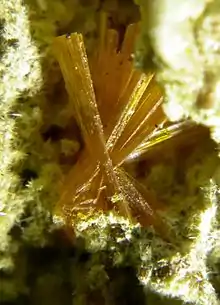Becquerelite
Becquerelite is a uranium mineral with the chemical formula: Ca(UO2)6O4(OH)6·8(H2O). It is a secondary mineral which contains calcium and is a bright yellow colour. It has a Mohs hardness of about 2.
| Becquerelite | |
|---|---|
 Spray of becquerelite crystals with uranophane needles from the old Shinkolobwe mine | |
| General | |
| Category | Oxide mineral |
| Formula (repeating unit) | Ca(UO2)6O4(OH)6·8(H2O) |
| IMA symbol | Bqr[1] |
| Strunz classification | 4.GB.10 |
| Crystal system | Orthorhombic |
| Crystal class | Pyramidal (mm2) H-M symbol: (mm2) |
| Space group | Pn21a |
| Unit cell | a = 13.8378 Å, b = 12.3781 Å, c = 14.9238 Å; Z = 4 |
| Identification | |
| Colour | Amber-yellow, golden to lemon-yellow, yellow-orange, brownish yellow |
| Crystal habit | Tabular prismatic striated crystals exhibiting pseudohexagonal outline; coatings and fine-grained aggregates |
| Cleavage | Perfect on {001}; imperfect on {101}, {010} and {110} |
| Tenacity | Brittle |
| Mohs scale hardness | 2.5 |
| Lustre | Adamantine to greasy |
| Streak | Yellow |
| Diaphaneity | Transparent |
| Specific gravity | 5.09 - 5.2 |
| Optical properties | Biaxial (-) |
| Refractive index | nα = 1.725 - 1.735 nβ = 1.815 - 1.825 nγ = 1.825 - 1.830 |
| Birefringence | δ = 0.100 |
| Pleochroism | X = colourless to pale yellow, Y = Z = yellow to deep yellow |
| 2V angle | Measured: 32° |
| Common impurities | Commonly contains lead |
| Other characteristics | |
| References | [2][3][4] |
It was named after the French physicist Antoine Henri Becquerel (1852–1908), who discovered radioactivity in 1896. Becquerelite contains about 70% uranium by weight.
It is mainly mined in Kasolo of the former Zaire, in the present day Democratic Republic of the Congo.
References
- Warr, L.N. (2021). "IMA–CNMNC approved mineral symbols". Mineralogical Magazine. 85 (3): 291–320. Bibcode:2021MinM...85..291W. doi:10.1180/mgm.2021.43. S2CID 235729616.
- Handbook of Mineralogy
- Mindat.org
- Webmineral data
This article is issued from Wikipedia. The text is licensed under Creative Commons - Attribution - Sharealike. Additional terms may apply for the media files.